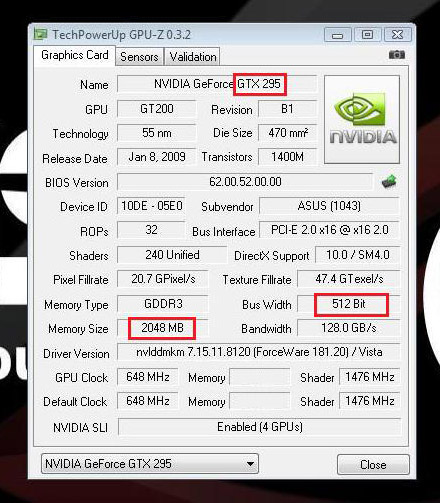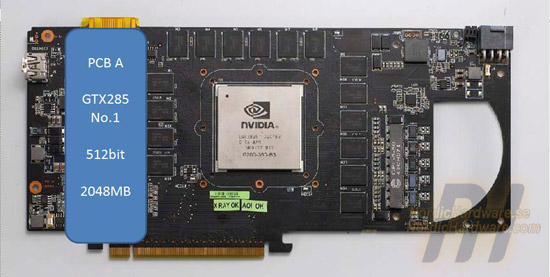While waiting for the next generation graphics circuits ASUS has created a real GeForce monster with 4GB graphics memory and dual GeForce GTX 285 circuits that has already broken world records.
Rumors are going around the graphics card industry like never before and every time a new generation is about to launch the stream of stories becomes thicker and thicker, and it far from easy to dig through all the possible facts that these reports may contain. What we all most certainly know though is that both AMD and NVIDIA are working on very powerful graphics circuits that will not only bring DirectX 11 but also considerably more crunching power to the table.
Even if the first rumored specifications of both AMD’s and NVIDIA’s new cards are quite impressive they are still unconfirmed, at the same time it is unclear when we will actually see any of them in stores. Not just because AMD and NVIDIA are reluctant to reveal any possible launch dates but also because they most likely don’t know yet. Both AMD RV870 and NVIDIA’s G300 (also known as GT300) will be made by TSMC and its new 40nm process. The problem is that the 40nm process has been problematic for TSMC and Radeon HD 4770, which is the first retail graphics cards using a 40nm graphics circuit, is hard to come by.
ATI Mobility Radeon HD 48×0 series was the first 40nm chips to be announced
If TSMC is in such strides to make a relatively simple chip like RV740 (826 million transistors) we do not dare to guess the yields of a high-end circuit like RV870 or G300 would get. NVIDIA’s G300 is rumored to consist of almost three times as many transistors as RV740, around 2.4 billion transistors.
But even if TSMC would get things in order it will take another couple of months before AMD and NVIDIA can launch its new architecture, I.e. hard launch, and today the fourth quarter this year looks like the most plausible launch period.
Until then it has kept lips tight, at least if we consider the high-end models. NVIDIA is expected to get by on its GeForce GTX 285 and new single-PCB version of GTX 295, which could create a bigger than normal gap between current and coming generations.
As it turns out at least one graphics card manufacturer has no intention of waiting until the next generation graphics cards arrive, and develop its own solution for moving graphics performance to new levels today.
The company in question is ASUS and the card in question is a real beast called ASUS MARS GTX295.
ASUS is the world’s biggest component manufacturer with resources matched by few, if any competitor. ASUS is usually fast to come up with its own solutions for both motherboards and graphics cards, and its latest creation is perhaps the coolest we’ve seen so far. At least when you consider the fact that ASUS is locked by the chips and technologies used by the graphics circuit maker, in this case NVIDIA.
ASUS Mars GTX295 is and on distance looks like a regular GeForce GTX 295 although in a bit beefier costume. We have it confirmed that the cooler ASUS has used with its Mars prototype will not be the one on the retail model, but the card will not be longer than the regular GTX 295, only a bit higher.
When you take off the cooler and look under the hood of Mars GTX 295 you see what makes ASUS’ new card different from the regular GeForce GTX 295 cards. First of all Mars use dual PCBs, but for a simple reason. ASUS Mars GTX 295 is more or less two GeForce GTX 285 graphics cards connected under one and the same cooler.
That is what has made it possible for ASUS to more or less crush NVIDIA’s reference version of GeForce GTX 295 in heavy benchmarks.
The two G200b graphics circuits used have every possibility to achieve the most extreme results with 12 phase power supply (6 phases with each GPU) and a memory system like no other. Through a Volterra voltage regulator you can also change the graphics circuit voltage through software.
ASUS has endowed each GPU with 2GB memory buffer and 512-bit memory bus, which means that Mars GTX 295 has a total memory buffer of no less than 4GB and a memory interface of a total of 1024-bit. None of these achievements have been seen before with a retail graphics cards, even less with "one" graphics card.

ASUS Mars GTX 295 in Quad-SLI (8GB GDDR3 memory in total)
|
The memory circuits are GDDR3 and specified to operate at 1300MHz (0.77ns memory chip), but operate at 1200MHz (2400MHz effectively) with Mars GTX 295.
The graphics circuits operate at the same clock frequency as with GTX 285, thus 648MHz each, which is a substantial increase from the 576MHz the regular GTX 295 operate at.
Below is a summarize of the specifications and in comparison to NVIDIA’s reference model of GTX 295.
|
Mars GTX 295
|
NVIDIA GTX 295
|
|
|---|---|---|
|
Graphics circuit
|
G200b
|
G200b
|
|
Process
|
55nm
|
55nm
|
|
GPU voltage
|
1.15V
|
1.15V
|
|
Power supply
|
12 phases (digital)
|
6 phases (analog)
|
|
GPU frequency
|
648MHz
|
576MHz
|
|
Shader frequency
|
1 476MHz
|
1 242MHz
|
|
Memory frequency
|
2400MHz
|
1 998MHz
|
|
Memory bus
|
2x 512-bit
|
2x 448-bit
|
|
Memory buffer
|
2x 2 048MB (GDDR3)
|
2x 875MB (GDDR3)
|
|
Memory bandwidth
|
307.2 GB/s
|
223.8 GB/s
|
Those of you who follow the news here at NordicHardware it is no secret that overclocking guru Marcus “Kinc” Hultin is a former crew member. Marcus now works at ASUS has been testing the new card and done some overclocking with Mars GTX 295 to see what the card can do, and we have been handed some results.
Before we move on to the benchmarks we have to say that these were not performed by NordicHardware, which in no way makes them less interesting.
According to Marcus the first overclocking tests were rather simple and even if the graphics cards were cooled by liquid nitrogen they were cooled without isolation, while the Core i7 processor wasn’t overclocked to any significant degree.
With an Intel Core i7 Extreme 965 processor clocked at 4785MHz and two ASUS Mars GTX 295 graphics cards in Quad-SLI Marcus managed to score a world record. By pushing the four graphics circuits to 833MHz in 3DMark Vantage Extreme. The end result was 25057 points with a memory clock of 2558MHz. A result that can be improved further with better cooling and even higher clock frequencies.
System specifications:
– Intel Core i7 Extreme 965 CPU (4785MHz with liquid nitrogen)
– 2x ASUS Mars GTX 295 (833MHz GPU, 2558MHz memory with liquid nitrogen)
– ASUS Rampage II Extreme
– Corsair Dominator GT GDDR3 memory
–
Corsair HX1000W power supply
The graphics circuits were cooled down to about -45C° but is said to handle -120C° where clock frequencies around 1GHz should be possible. Exactly how long the card will become is hard to say, but in a few weeks Marcus and NordicHardware’s overclocking expert Robert ‘crotale’ Kihlberg will get a chance to really show what the card can do.
What happens now?
ASUS has created an almost perfect tool for marketing its graphics products with Mars GTX 295, but at the same time it has shown that it can raise the bar for graphics card performance substantially, even without new architecture and technologies.
What we’ve seen today are pure overclocking benchmarks and even if we believe that this is how most samples Mars GTX 295 will be used we are eagerly awaiting some more normal benchmarks with games and such. Crysis with 4GB graphics memory and over 300GB/s memory bandwidth should present some interesting results., or why not the double with a Quad-SLI configuration?
ASUS Mars GTX 295 will be a limited edition with only 1000 samples made, which will hardly fill the large void while most are awaiting the next generation graphics circuits. But as hardware enthusiasts we are glad to see the initiative taken by ASUS to develop its own graphics card solution, unlike the heap of reference-based graphics cards that are flooding the market.
ASUS has shown its strength on the graphics card market while NVIDIA has something to be glad about. When this is posted we haven’t heard about any other manufacturer with similar plans, but we can’t exclude it.
ASUS Mars GTX 295 will first of all appear at Computex next week and the idea is to make 1000 units. But when and at what price is yet to be revealed.































